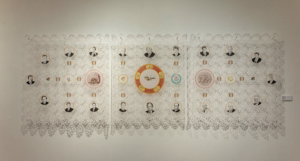Merrymaking: Laura Graham’s Work in Southern Futurisms
Laura Graham is a Georgia-native artist who explores the contemporary issues of the American South through textile prints. Lace patterns, domestic imagery, and colonial symbols all permeate her work to create a recognizable Southern aesthetic, one that many people from the South may find nostalgic. At MoFA’s juried exhibition featuring artists who think of their work as a lens through which to consider the future of the South, Combined Talents: Southern Futurisms, Graham’s piece Merrymaking (2019) won third place. The work is a great example of her practice.

Merrymaking, Laura Graham, 2019, Ink on Hand-Cut Mylar, 42 x 120 x 6
Merrymaking is composed of 3 panels of mylar, which are hand-cut into delicate lace by the artist to form a large doily. The piece is modeled after a table-scape that would perhaps be displayed at a wedding–but instead of pleasant decorations, the doily is littered with images of men in power who have been accused of sexual assault. Merrymaking gains its name from certain Dutch doilies, called “merrymaking patterns,” which depict intoxicated men assaulting the women around them in a manner that is meant to be humorous. In Merrymaking, those scenes are replaced by black and white portraits of the accused men.
The doily itself is a simultaneously feminine and colonial symbol, often found in Southern homes. It originates as a European practice that found its way into colonial homes, from South Africa to the American South, as a status symbol. Domestic decoration has been historically regarded as a feminine aesthetic, with the doily being an adornment of choice for many homemakers especially in colonies where the doily was a colonial import. Displaying these men’s wrongdoings on an object usually associated with the sanctity of the home sheds light on how their actions went directly against their own “family values” platforms. There is also a shocking disconnect between the fragile nature of the work and the social issues displayed, prompting the viewer to consider other contradictions within American culture. These male politicians are meant to be “family men” and trusted figures, and yet they commit atrocities and are pardoned by society for them–continually respected by society, even, as their portraits in Merrymaking are quite serious and dignified despite the clear “merrymaking.”
The colonial aspects of the doily lead us to think about the historical context that had led to the pardoning of these men’s crimes as well. White House china is featured prominently, from central designs to small gold trims surrounding portraits. The china shown comes from various offices which furthered a dominant male-culture in America, such as the Polk and Monroe administrations. Colonialism is a system of domination, and that is reflected in the projection of these controversial, dominant figures onto a delicate doily. Portraying the figures as a part of an antique object also emphasizes them as being within the colonial past. As Graham stated herself, the work “capitalizes on America’s propensity for nostalgia to lure the viewer into confronting injustices through the detached lens of that which has already happened.” The “now” becomes “that which has already happened” in Merrymaking, revealing a way for all viewers to fully be critical of current-day issues.
In Southern Futurisms, Graham’s work prompts us to consider the contemporary issues of the South through a lens of nostalgia. Traditional American values come into question, and as viewers we are asked: should our present continue to mirror the past, or should we change our futures?
References
- Maphangwa, Shonisani. “From Colonial to Post-Colonial: Shifts in Cultural Meaning in Dutch Lace and Shweshwe Fabric.” University of Johannesburg (South Africa), 2010.
- Jonathan Ferrara Gallery. “Laura Tanner Graham,” n.d. https://www.jonathanferraragallery.com/artists/laura-tanner-graham/featured-works?view=slider#7.
About the Author
Caelen is going into their senior year at FSU majoring in art history. They have an interest in Latin American art and the museum field, and enjoy spending their time researching and drawing. They began volunteering at MoFA this summer to get more involved in the arts on campus and gain more experience working in museums, and are excited to work with MoFA’s collections! After graduating in 2024, they hope to continue their studies in a masters program for art history.